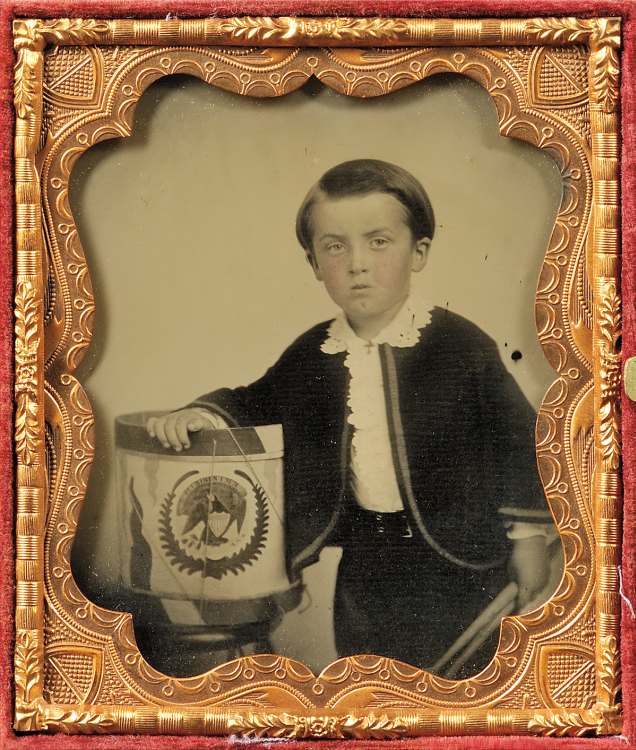
Lot 113: Half Plate Daguerreotype Portrait of Two Hunters with Game and Sleeping Dog, Est. $1,500-2,500
Daguerreotypes are a reminder of a time when photography was very different from the “point-and-shoot” instant pictures of today. Now, you carry a camera in the cell phone in your back pocket everywhere you go. Then, as now, photographers were purveyors of state-of-the-art technology.
In fact, the 19th century photographers who made these long-exposure images were referred to as daguerrean artists, and quickly supplanted the portrait painters of the day. The artists’ “images,” particularly daguerreotypes, were valued for their clarity and honesty in representation.
Other than the careful arrangement of a composition, the daguerrean photographer almost never altered an image in any way, except for portraits with pink-tinted cheeks, or gold-highlighted jewelry and buttons.
Daguerrean artists did, however, use interesting means to achieve compositional effects that would otherwise be limited by long exposure times. In the ambrotype pictured here, depicting a man pouring milk from a pitcher, the “milk” is actually a white cloth.
The long exposure times needed for daguerreotypes and other forms of early photography also cause families, soldiers, children, and laborers to look out from stiff, unsmiling poses. It could be a long and strenuous task to sit for one of these images. Yet, if you look closely, the lives and loves of the subjects become clear, and the 19th century doesn’t feel quite so distant.
On October 30, 2011, the American Furniture & Decorative Arts auction will open with 150 lots of daguerreotypes, ambrotypes and tintypes from the Early Photography collection of Rod MacKenzie.
As a collector, Rod MacKenzie has a sophisticated taste for images that speak to him – and now to us – emotionally, historically, and artistically. He understands well the limitations of early photography, and carefully collects images which, though mainly portraits, show us more than just what the sitter looked like.
There are signs of life throughout the images in his collection – children holding toys close, workmen demonstrating tools of their trade, and soldiers exuding confidence and swagger.
In addition to the portraits, MacKenzie collects images that tell stories. Among the best of these is a set of so-called “occupationals.” There are dozens of images that convey a strong sense of narrative: portraits of beautiful, elegantly dressed women give us a window into the day’s style; prosperous young couples exude airs of optimism; and men show their skill at their daily occupations. This group includes some of the rarest examples MacKenzie gathered: an architect seen in his office at a desk with his drafting tools and elevation drawings of Italianate houses on the walls behind him, a blacksmith at his anvil, a mailman, farmers, a banjo player, a string quartet, a bugle player, carpenters, buggy drivers, and firemen.
In Part II of this series, we’ll take a look at some of the highlights of this truly astounding collection. Every time I turn a page in the catalogue, I seem to find something new in one of these images that I hadn’t seen before. Which images speak most strongly to you?



Pingback: Daguerreotypes | The Early Photography Collection of Rod MacKenzie | Part II
Hello: I’m interested in Knowing if I can submit an Antique & famous Photograph for an addition to this upcoming Boston auction that will have attracted phot customers. Item is as follows : Recent estate find- Martha H. Harvey photograph- image size 11×14 inches mounted to original gray photo board-titled Midsummer Storm in pencil on back. Incised stamp lower right into photograph “COPYRIGHT 1899 BY MARTHA H. HARVEY” Total size is 17×20 inches- Women photographers were not plentiful during this period. Harvey’s works are held by the NY Historical Society. mounted on the original card stock. Scene could be Maine or New England Coastal Scene from Cape Cod…. I’m also sending photos of this photograph on your Auction Evaluations form. Thank you: Stephen
Thank you for bringing your photograph to our attention and for submitting it through our Auction Evaluations form. While the October auction is already finalized, we would be happy to take a look and consider this item for a future auction.
Fig. 64. I feel he is looking out, more so than the others.
Pingback: Daguerreotypes | Ambrotypes | Tintypes
Pingback: How to Identify a Daguerreotype | Early Photography Collecting